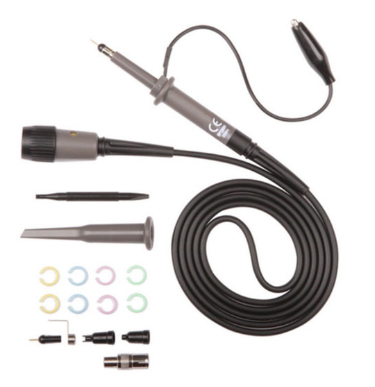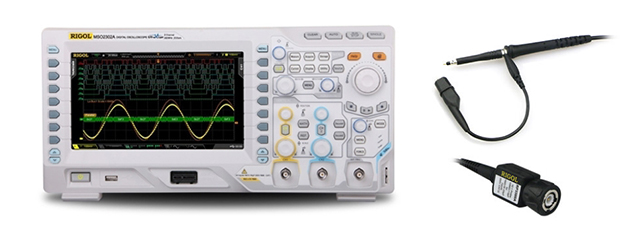What is an Oscilloscope Probe?
Oscilloscope Probe Definition
The oscilloscope probe is mainly used to guide the measured voltage signal from the measuring point into the oscilloscope for measurement. Probe is crucial to the accuracy and correctness of the measurement results, as it's the electronic component connecting the measured circuit and the input of the oscilloscope. The simplest probe is a wire that connects the measured circuit and the input of the oscilloscope, a complex probe consists of resistor-capacitor unit and active devices. A simple probe has no shielding measures, so it's susceptible to external electromagnetic interference. Meanwhile, larger equivalent capacitance in it would increase the load on the measured circuit, thus leading to distortion of the measured signal.
The oscilloscope probe establishes a physical and electronic connection between the test point or the signal source and the oscilloscope. Actually, an oscilloscope probe is a device or network that connects the signal source to the input of oscilloscope, it has to provide a convenient and quality connection between the signal source and the oscilloscope input. Three key problems are concerned with the adequacy of connection, namely physical connection, influence on circuit operation and signal transmission.
Most probes consist of a probe head, probe cable, compensation device or other signal conditioning networks and probe connector. To conduct an oscilloscope measurement, the probe head must be physically connected to the test point. To achieve this purpose, most probes have a long cable of 1~2 meters. However, the probe cable reduces probe bandwidth: The longer the cable is, the greater reduction of bandwidth. Except for a long cable, many probes are equipped with a probe head or probe handle, the probe head can fix the probe and users can move the probe to touch the test points. Generally, the probe is a hook with spring support, it can connects the probe with the text point. In order to obtain available measurements, the signal on the probe must be transmitted to the oscilloscope input with sufficient fidelity through the probe head and cable.
Oscilloscope Probe Types
70 MHz to 1 GHz bandwidth of digital oscilloscopes are available on ATO.com. The oscilloscope probes can be divided into passive probe and active probe according to whether or not it needs power supply, it can also be divided into voltage probe, current probe and light probe according to the type of measured signals. The so-called passive probe means that the whole probe is composed of passive components, such as resistors, capacitors and cables. Active probe is generally equipped with an amplifier inside, the amplifier needs power supply, so it's named. In the oscilloscope, the high resistance passive probe has a high input impedance but low bandwidth, however, the low resistance passive probe has a high bandwidth but low input impedance. The following is a schematic of a 10:1 high resistance passive probe.
1. Active voltage probe: It's generally applicable to single-ended signals with a bandwidth greater than 500 MHz and a range less than 3 V positive or negative.
2. Passive probe: It's generally applicable to test single-ended signals with a bandwidth less than 500 MHz. It's a relatively economical probe.
3. Differential probe: It's generally used for testing differential signals, and it can be divided into high bandwidth probe and high voltage probe. High voltage differential probe can test differential signals up to 4400 volts, high bandwidth differential probe can test high-speed signals with a band of up to 12.5G.
3. Current probe: Generally, current signal is tested through Hall effect and test range is generally from DC to 2G. The range varies from 1mA to 20000 A.
4. Low-capacitance probe: This probe is setting for matching. Currently, such a probe is rare in the market and it can measure a bandwidth of up to 9G Hz.
5. High voltage probe: It's suitable for high voltage signals and can measure a voltage up to 4000V. It can be divided into single-ended probe and differential probe.

